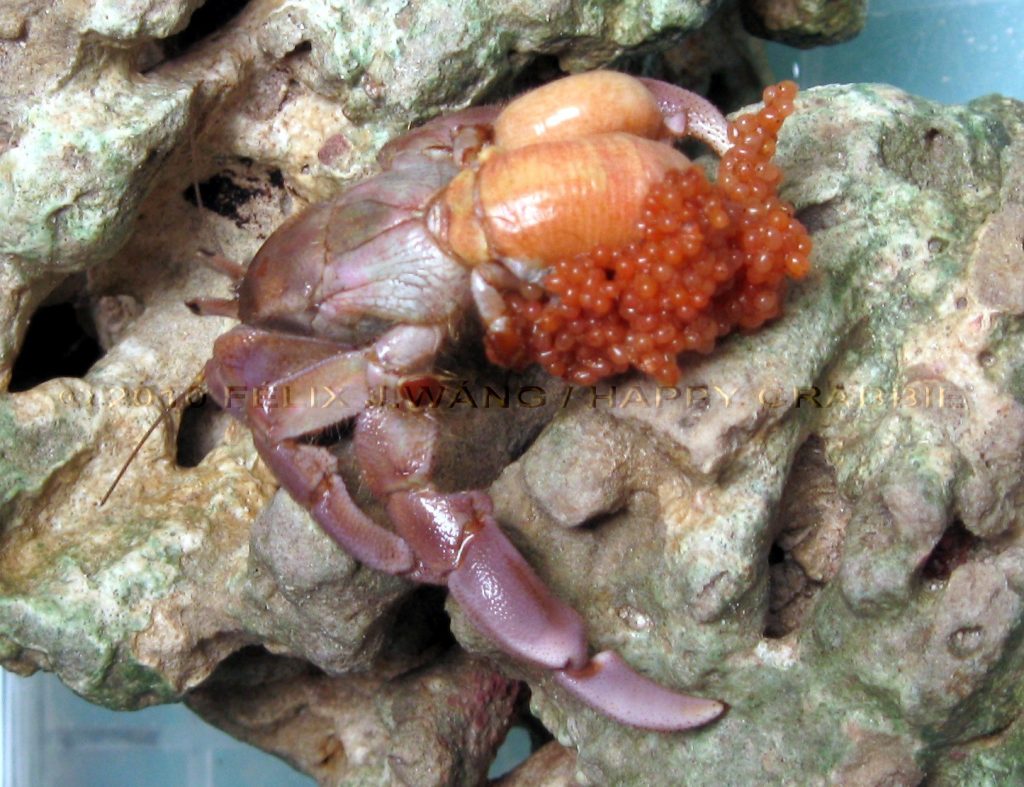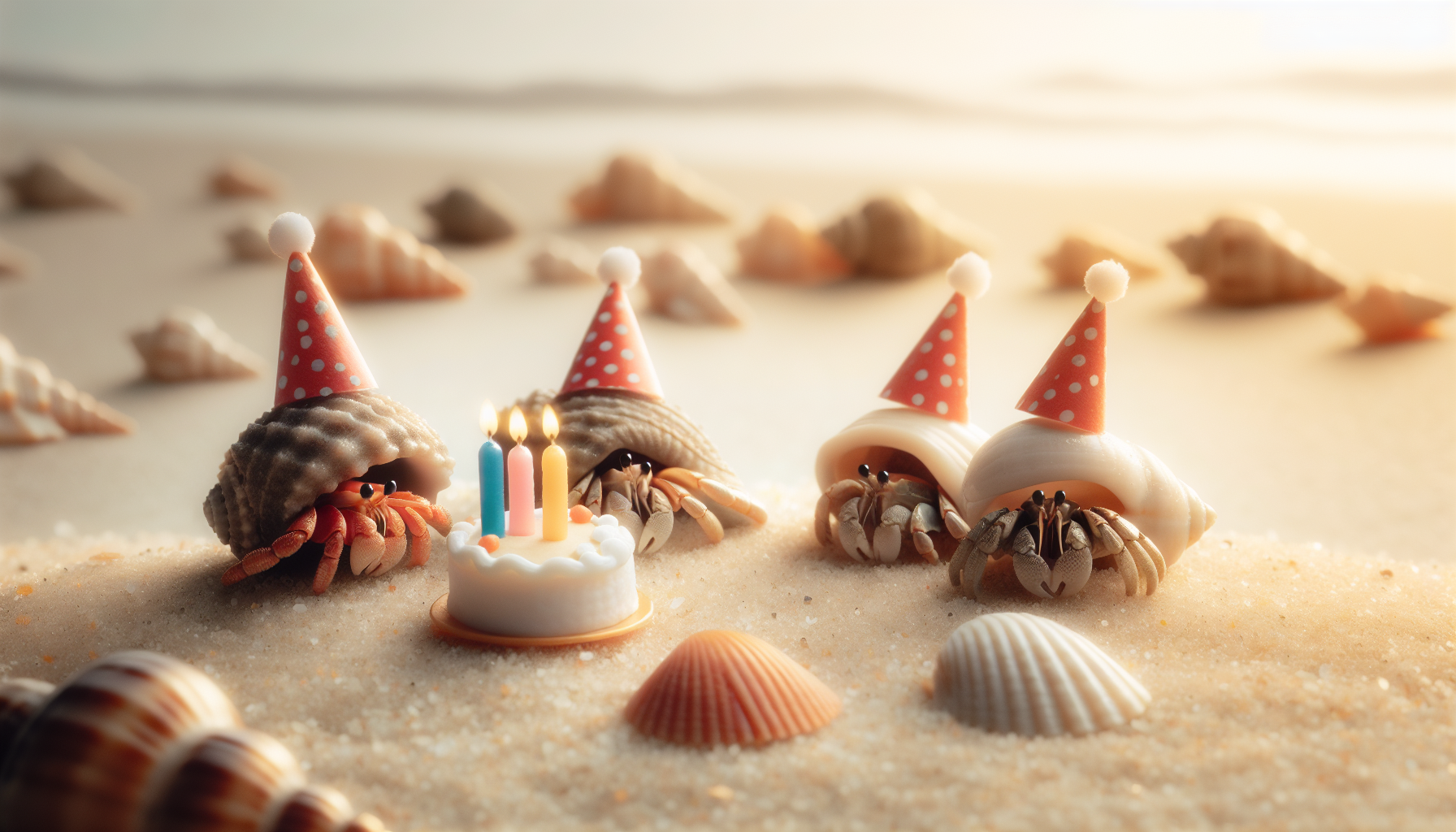Originally written by Vanessa Pike-Russell, edited and updated by Stacy Griffith
Thu, Oct. 12th, 2006, 10:40 pm
Keeping and breeding land hermit crabs
Foreword:
Hello. My name is Vanessa Pike-Russell. Stu Wools-Cobb visited my website on land hermit crab care and emailed me after reading my caresheet on gender and reproduction. At the time it had been unheard of for land hermit crabs to have successfully reproduced in captivity and the resulting eggs raised to juvenile (air-breathing) stage of development.
A few emails, phone calls later, and Stu sent me a copy of his booklet that was created in part for his local aquarist society. Through his extensive background in breeding fish and raising brine shrimp he was able to raise the hermit crab zoea with the materials he had on hand (see pages 10-12) and fed them a diet rich in nutrients similar to those they would have access to in the intertidal pools of the wild. A steady routine of hand-feeding every two hours contributed to his success – and it is his desire to share his knowledge and success with other land hermit crab enthusiasts with the hope that others will obtain similar results.
Before you view this document, you are asked to be very mindful that it is for personal viewing only. Do not sell, re-sell, publish or distribute this booklet for commercial purposes. Any plagiarism of content contained within this booklet may result in legal action. All work remains the sole intellectual property of Stu Wools-Cobb and should not be used in any way without permission.
Stu Wools-Cobb has given written permission for Vanessa Pike-Russell of About Land Hermit Crabs (www.aboutlandhermitcrabs and http://users.tpg.com.au/vanessap/ ) permission to share this information on her personal site and on the magazine The Crab Street Journal of which she is a producer and webmaster. Any other use of this material is considered in breach of this agreement so please be very mindful of the terms on which it is shared.
It was always thought that hermit crabs would not breed in captivity. Now, it seems, some have successfully bred with suitable conditions. While we are still working out what they are, it is obvious to all that if the hermit crabs are given enough room to move about in; both a fresh water bowl and a salt water pond; a balanced diet including carrion-type foods high in protein and calcium; humidity and temperature in the ideal range; and enough shells for growing and fussy bodies. While we are not sure what makes some hermit crabs breed and others not, it is important that their home meets all their needs, and yields a better chance of survival.
While hermit crabs have successfully bred, it is much harder to successfully hatch and raise the land hermit crabs. Since the first stage of development of land hermit crabs is an aquatic one, the eggs will need to be released into, or placed in, an aquatic environment to simulate the time spent in inter tidal pools as part of plankton.
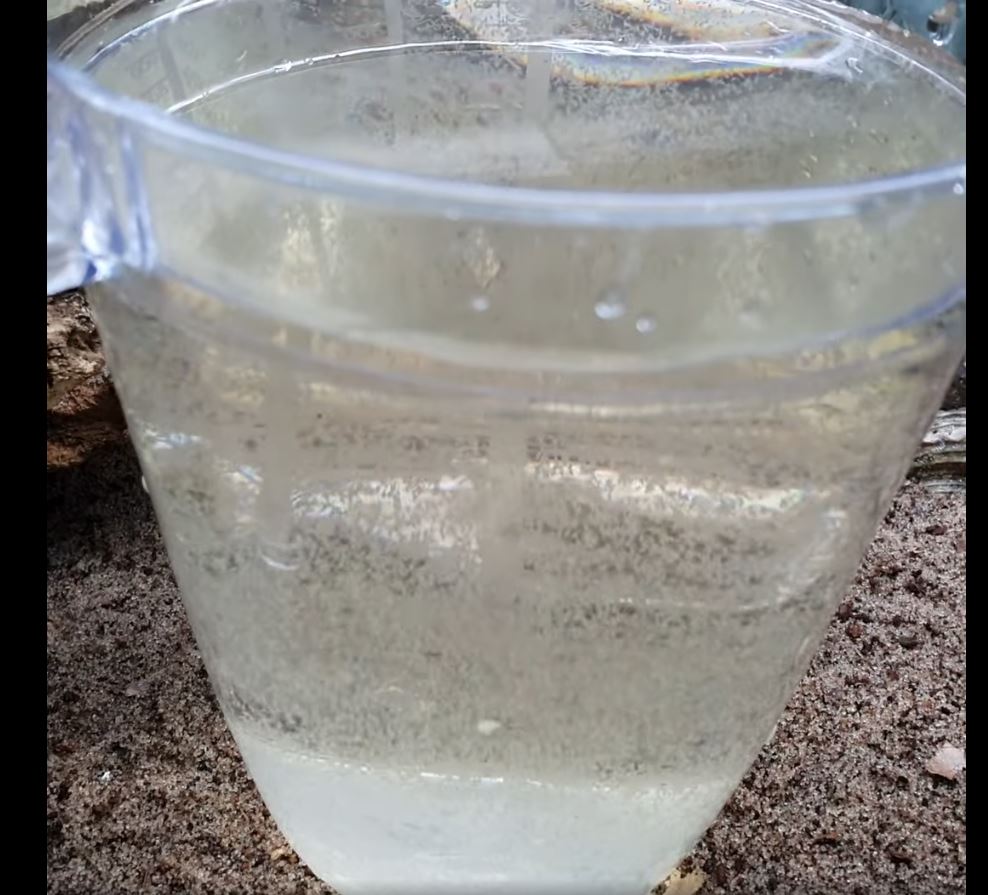
Unless you have the time and ability to raise the zoea to juvenile (air-breathing) stages, there is little chance they will survive. At each stage of development within the aquatic stage, the zoea (free swimming larvae) need to be fed by hand and kept in conditions which may be difficult for most. However, if you are able to raise land hermit crabs to juvenile stage, there is a good chance that the health of these offspring will be optimal, depending on feeding and conditions.
Visit Hermit Crab Breeding for a record of successful captive breeding of land hermit crab species Coenobita.
A hermit crab that is gravid (carrying eggs) will look like the image below from Felix Wang. “A female crab attaches her eggs to the fine setae on her pleopods using a glue like substance.” Fox, Sue. 2000
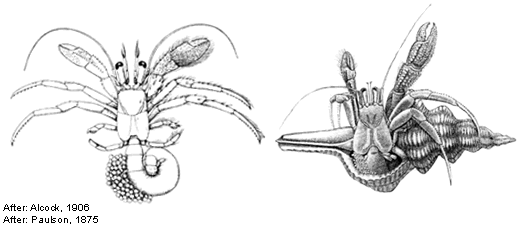
Helfman 1997a: described the copulatory behaviour of B. latro from observation of a single event. Both male and female crabs were in the intermolt phase during copulation. The male approaches the female slowly, clasps the dorsal meri of the chelipeds, and quickly moves forward to turn the female onto her back. Abdomens are extended, the male deposits the spermataphore, and the pair disengages.
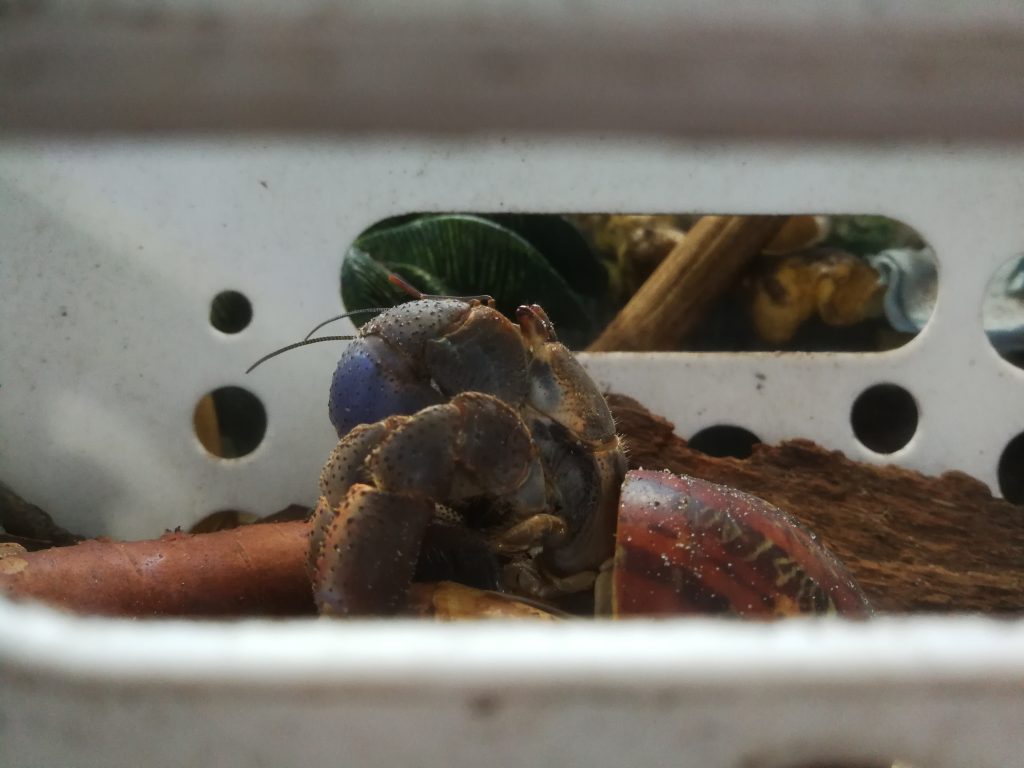
The copulatory behaviour of other coenobitids apparently lasts much longer than for Birgus. Hazlett(1966) and De Wilde (1973) depicted the migration and reproductive behaviours of Coenobita clypeatus, but no copulatory activity was recorded. Observations of mating of C. clypeatus in the field, confirmed by the presence of a spermataphore on the female, have been made (S. Gilchrist, unpub). Initiation begins by the male grasping the aperture of the female’s shell and moving her shell from side to side. A series of rocking and tapping motions either stimulates the female to extend from the shell, in which case mating proceeds ventral to ventral, or the female retracts father into the shell and the male releases the shell. Page and Willason (1982) noted copulatory behaviour in C. perlatus. Mating occurs during migration to the sea proceeding larval release. Mating is ventral to ventral with both crabs about three-quarters out of their shells. Males pass the spermataphore to the females using the modified pereiopods. Mating may occur before release of the developed egg mass.
Dunham, D. W., and S. L. Gilchrist. 1988. p. 119

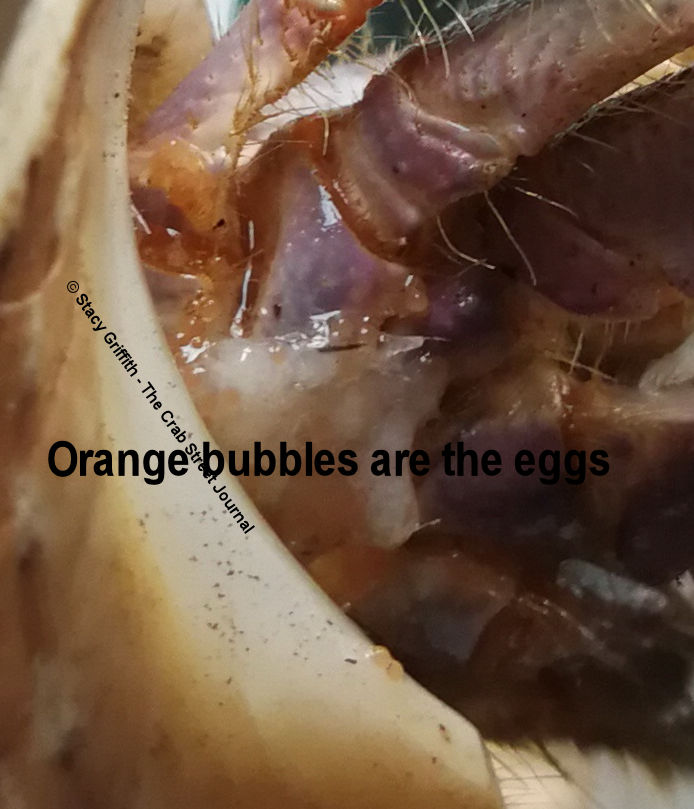
Shell utilization by the land hermit crab Coenobita scaevola from Wadi El-Gemal, Red Sea by Salam WS, Mantellato FL & Hanafy MH
Ovigerous females may be taking shelter at other points along this beach showing a cryptic habit during daylight and active at night as C compressus, a common occurrence observed among ovigerous females of crustaceans; Particularly for C. scaevola and other coenobitids showed either daily or season migrations depending upon rainfall. Also, spawning females of C. clypeatus presented unusual pattern since they did not enter the water, but move toward the sea at low tide to drop or fling their eggs onto the wet rocks.

Hermit crab mating videos from YouTube:
Captive bred hermit crabs
Hermit crab eggs
Captive bred hermit crab zoea and megalopa
References:
Brodie, R.J. 1998. Movements of the terrestrial hermit crab, Coenobita clypeatus (Crustacea, Coenobitidae). Revista de Biologia Tropical 46 (Suppl. 4): 181–185.
DeWilde, P. A. W. J. 1973. On the ecology of Coenobita clypeatus in Curaçao. Stud. Fauna Curaçao Other Caribb. Isl.144:1–138.
Dunham, D. W., and S. L. Gilchrist. 1988. Behavior. Pp. 97-138 in Biology of the Land Crabs, W. W. Burggren and B. R. McMahon, eds. Cambridge: Cambridge University Press.
Fletcher, W.J., Brown, I.W., Fielder, D.R., and Obed, A. 1991a.
Structure and dynamics of populations. Pp. 61–85 in: Brown, I.W.,
and Fielder, D.R. (eds), The coconut crab: aspects of Birgus latro
biology and ecology in Vanuatu. Canberra. Aciar Monographs 8.
Fletcher, W.J., Brown, I.W., Fielder, D.R., and Obed, A. 1991b. Moulting and growth characteristics. Pp. 35–60 in: Brown, I.W., and Fielder, D.R. (eds), The coconut crab: aspects of Birgus latro biology and ecology in Vanuatu. Canberra, Aciar Monographs 8.
Fox, S. Hermit Crabs: A Complete Owners Pet. Barron Books Pub.
Hazlett, B.A., 1966. Social behavior of the Paguridae and Diogenidae of Curaçao. Studies on the Fauna of Curaçao and other Caribbean Islands, 23: pp.1-143
Hazlett, B.A. 1981. The behavioral ecology of hermit crabs. Annual Review of Ecology and Systematics 12: 1–22.
Harvey, A. Text from a personal email to Vanessa Pike-Russell from Alan Harvey regarding determining the gender of a land hermit crab. Shared with permission. For more information about Alan Harvey and his research, please visit this link: http://www.bio.gasou.edu/bio-home/harvey/research.html
Helfman, G. S. 1973. Ecology and Behaviour of the Coconut Crab, Birgus latro (L). Masters thesis, University of Hawaii, Honolulu.
Hicks, J., H. Rumpff, and H. Yorkston. 1990. Christmas Crabs., Golden Earth Design and Printing, Singapore.
Gray, H. S. 1995. Christmas Island Naturally., Scott Four Colour Print, Perth, Western Australia. Pp. 11–145.
Harvey, A. Text from a personal email to Vanessa Pike-Russell from Alan Harvey regarding determining the gender of a land hermit crab. Shared with permission. For more information about Alan Harvey and his research, please visit the link below
http://www.bio.gasou.edu/bio-home/harvey/research.html
Jones, S. and Morgan, G.J. (1994) A Field Guide to Crustaceans of Australian Waters. Western Australian Museum. Chatswood, N.S.W. (Australia) : Reed Books, 1994. ISBN 0 7301 0403 6
Lowry, J.K. (1999 onwards). ‘Crustacea, the Higher Taxa: Description, Identification, and Information Retrieval.’ Version: 2 October 1999. http://crustacea.net/
Morgan, S. G., and J. H. Christy. 1995. Adaptive significance of the timing of larval release by crabs. Am. Nat.145:457–479.
http://www.biolbull.org/cgi/external_ref?access_num=A1995QL57300007&link_type=ISI
Page, H.M., and Willason, 1982. Distribution Patterns of terrestrial hermit crabs at Enewetak Atoll, Marshall Islands. Pacific Sci. 36:107-117
Vannini, M., and G. Chelazzi. 1981. Orientation of Coenobita rugosus (Crustacea: Anomura): A field study on Aldabra. Mar. Biol.64:135–140.
http://www.biolbull.org/cgi/external_ref?access_num=A1981MK95900004&link_type=ISI
Vannini, M., and S. Cannicci. 1995. Homing behaviour and possible congitive maps in crustacean decapods. J. Exp. Mar. Biol. Ecol.193:67–91.
http://www.biolbull.org/cgi/external_ref?access_num=A1995TL47700007&link_type=ISI
Wolcott, T. G. 1988. Ecology. Pp. 55-96 in: Biology of Land Crabs (W. Burggren and B. McMahon, Eds.), Cambridge University Press, New York.

